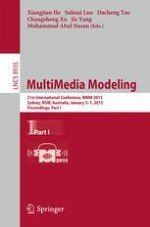The two-volume set LNCS 8935 and 8936 constitutes the thoroughly refereed proceedings of the 21st International Conference on Multimedia Modeling, MMM 2015, held in Sydney, Australia, in January 2015. The 49 revised regular papers, 24 poster presentations, were carefully reviewed and selected from 189 submissions. For the three special session, a total of 18 papers were accepted for MMM 2015. The three special sessions are Personal (Big) Data Modeling for Information Access and Retrieval, Social Geo-Media Analytics and Retrieval and Image or video processing, semantic analysis and understanding. In addition, 9 demonstrations and 9 video showcase papers were accepted for MMM 2015. The accepted contributions included in these two volumes represent the state-of-the-art in multimedia modeling research and cover a diverse range of topics including: Image and Video Processing, Multimedia encoding and streaming, applications of multimedia modelling and 3D and augmented reality.
